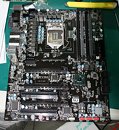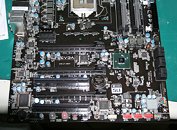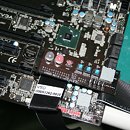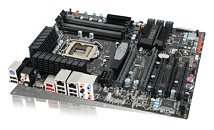Friday, July 24th 2009

EVGA's Enthusiast Platform for LGA-1156 Processors Detailed
EVGA seems to have found its roots in Intel's 5-series chipset due to lack of chipsets from NVIDIA that support the latest Intel processors. In the process, EVGA gets to make Intel 5-series motherboards brandishing SLI support, as well as some pretty impressive enthusiast-grade features. With the X58 Classified series, EVGA took on the mighty ASUS to give out a full-featured motherboard for overclocking LGA-1366 processors. It looks like the company is working on another motherboard with similar credentials for LGA-1156 socket processors, based on the Intel P55/P57 chipset.
The EVGA 132-LF-E657 is a full-featured LGA-1156 motherboard focussed on overclocking. The CPU is powered by a lavish 12-phase circuit that makes use of DrMOS (driver-MOSFETs). The CPU socket further seats LICC (Low Inductance Ceramic Capacitors). Electrical stability is brought about by two 8-pin ATX CPU power connectors, a design first featured on the X58 Classified. Additional power stability for the expansion slots is brought about by a 4-pin Molex input. The four DDR3 DIMM slots are powered by a 3-phase circuit. Intel Braidwood technology is supported on this motherboard. The technology involves an NVRAM module that speeds up OS and applications loading. There are two clock generators on this board, perhaps to handle two independent clock domains that gives the user greater control over a few settings.The expansion on this board is care of three PCI-E 2.0 x16 slots. Two of these are routed to the processor northbridge, and work electrically x8, x8, when both are populated. A third one is connected to the P55/P57 PCH, which is electrically x4. Other slots include one PCI-E x1, and two legacy PCI slots. The board further features PCI-E slot disable jumpers that cut off power to specific slots, turning off the associated voltage regulators.Apart from a plethora of enthusiast-friendly settings one might be able to find in the system BIOS setup utility, greater control is offered by EVGA ECP module that extends core motherboard controls on a PCB over a ribbon cable, including the PCI-E disable jumpers. Another feature is the redundant BIOS that stores three physical copies of the BIOS on separate EEPROM chips. EVGA may also include a motherboard control gadget that has a screen, a few control buttons, and lets users tune low-level overclocking settings on the fly. Not much is known about this gadget. On the peripheral connectivity front, the P55 PCH provides six SATA II ports, while an additional controller drives eSATA ports. 8-channel audio with digital IO, two gigabit Ethernet controllers, FireWire, and a number of USB ports make for the rest of it. The board may feature in the first wave of motherboard launches following the introduction of the processor platform.
Source:
XtremeSystems Forums
The EVGA 132-LF-E657 is a full-featured LGA-1156 motherboard focussed on overclocking. The CPU is powered by a lavish 12-phase circuit that makes use of DrMOS (driver-MOSFETs). The CPU socket further seats LICC (Low Inductance Ceramic Capacitors). Electrical stability is brought about by two 8-pin ATX CPU power connectors, a design first featured on the X58 Classified. Additional power stability for the expansion slots is brought about by a 4-pin Molex input. The four DDR3 DIMM slots are powered by a 3-phase circuit. Intel Braidwood technology is supported on this motherboard. The technology involves an NVRAM module that speeds up OS and applications loading. There are two clock generators on this board, perhaps to handle two independent clock domains that gives the user greater control over a few settings.The expansion on this board is care of three PCI-E 2.0 x16 slots. Two of these are routed to the processor northbridge, and work electrically x8, x8, when both are populated. A third one is connected to the P55/P57 PCH, which is electrically x4. Other slots include one PCI-E x1, and two legacy PCI slots. The board further features PCI-E slot disable jumpers that cut off power to specific slots, turning off the associated voltage regulators.Apart from a plethora of enthusiast-friendly settings one might be able to find in the system BIOS setup utility, greater control is offered by EVGA ECP module that extends core motherboard controls on a PCB over a ribbon cable, including the PCI-E disable jumpers. Another feature is the redundant BIOS that stores three physical copies of the BIOS on separate EEPROM chips. EVGA may also include a motherboard control gadget that has a screen, a few control buttons, and lets users tune low-level overclocking settings on the fly. Not much is known about this gadget. On the peripheral connectivity front, the P55 PCH provides six SATA II ports, while an additional controller drives eSATA ports. 8-channel audio with digital IO, two gigabit Ethernet controllers, FireWire, and a number of USB ports make for the rest of it. The board may feature in the first wave of motherboard launches following the introduction of the processor platform.





34 Comments on EVGA's Enthusiast Platform for LGA-1156 Processors Detailed
As for the board itself... I like the muted color scheme. Leaves a lot of room for your own color scheme (video card, heatsink, ramsinks, etc).
After all, progress is heresy! BURN EVGA!
fantastic layout, plenty of ports too, sata ports are in a good place, pci ex 1 slot is before the 16x slot thus not blocked
Does anyone know of any PSUs that have dual 8-pin ATX CPU connectors?
GOD *****ng dammit it has to be EVGA who bl***y makes it :banghead:
Sexy heatsinks, horrible molex placement, and finally, a desktop with a USB/eSATA combo port! Hopefully somebody will release a USB/eSATA combo port flash drive once these ports become more popular.
Shame it's Dual x8 and an x4, though. I think they should have added a few PCI-E lanes for a higher-end version.
The way I see it, LGA1156 is a socket for low end procs. i7 is high end, make enthusiast products for that...
i7 is the high-end socket. There are low-end i7 chips (dual core Xeon chips with no HT) and high-end i7 chips (975XE, etc.)
i5 is the mainstream socket. There are low-end i5 chips (dual cores) and high-end i5 chips (quad cores).
i3 is the budget socket. There will be low and high end chips as well.
It's like tiered categories, but there will still be enthusiast boards for each category, which will allow a mainstream buyer who doesn't need triple channel DDR3 to buy a great overclocking board with tons of options, like EVGA's offering above.